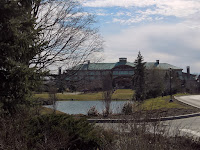 |
| Turning Stone Lodge before the Storm |
This year was the Professional Abatement Contractors of New York (PACNY) 22nd Annual Environmental Conference. This year's conference was overshadowed by Winter Storm Riley which turned into a Nor'easter and hit
Turning Stone Casino between Thursday night & Friday Morning, March 1-2, 2018 with about 7 inches of snow. Which put a dampener on attendance with only a few Long Islanders making the conference this year. However, the Vendor Display/Exhibit Hall seemed to have the usual amount of vendors, maybe we even had more than the usual. This year's schedule was a little different from past years in that presenters were given a little more time for their presentations and more time was given between presentations to spend in the Vendor Display/Exhibit Hall. As usual the PACNY Board did an excellent job of putting everything together, which special accolades to Ms. Deborah Sanscrainte of
Aramsco, the conference chairperson and Ms. Lisa Brown of Summit Environmental, Administrator.
 |
| Mr. Meacham discussing the Enforcement Process |
The first day, known as Proficiency Workshop day consisted of two presentations the first was Mr. James Meacham, PE, program manager for
New York State Department of Labor' (NYSDOL)'s
Asbestos Control Bureau (ACB), discussing "Solving the Mysteries of the Asbestos Control Bureau". Mr. Meacham's presentation went through the process of an inspection, the issuance of a Notice of Violation (NOV), and then continued with the process of resolving the NOV. His presentation did an excellent job of bringing transparency to the enforcement process. A key point of Mr. Meacham's presentation, was the response from the contractor (violator) issued the NOV. Contractors have two opportunities to address a violation, onsite during the inspection and the second time, is when responding to the written violation. Onsite, if their is no dispute contractors should stop work, fix the discrepancy(ies) and document the actions in the logbook. If there is a discrepancy, contractors should work towards complying with what can be done, document your position on the deficiency, and document your corrective actions in the logbook. When a violator receives a violation, the contractor should review the project with their staff, gather the compliance documentation, and submit a response to the NOV. This is important part of the process and could go a long way in mitigating violations.
 |
| Mr. Meacham discussing the Violation Review Process |
The second presenter was Mr. Kevin Hutton, of
Cornerstone Training Institute, discussing "Complexities of NYSDOL, OSHA, and
EPA". Mr. Hutton provided a handout called a "
Guide to NYS CR56-11.1 In-Plant Operations", this guide provided basic information regarding how Industrial Code Rule 56 handles the requirements for in-plant operations and what
Occupational Safety and Health Administration (OSHA) 1926.1101 work practices would apply under in-plant operations. In addition, Mr. Hutton's presentation, discussed NYSDOL Engineering Service Unit's addition of full-time project monitoring to many variance applications. The additions have included wording of what the responsibilities of the project monitor are for these variances (since Industrial Code Rule 56, itself, does not provide much information regarding that). Which brings up the question whether project monitors realize the scope of their responsibilities on such projects. We suspect not, since we've already seen some project monitors being issued violations for not following the variance requirements.
 |
| Mr. Hutton discussing full-time Project Monitoring added to Variances |
That ended the first day of presentations, with later that evening the PACNY President's (Joseph Cantone, of
Colden Corporation) reception was held, where many of us gathered and discussed concerns regarding the pending storm. Stay tuned for Part Two the Technical Sessions and the Vendor Reception!
 |
| Our waitress serving "The Gotham" at the TS Steakhouse |













